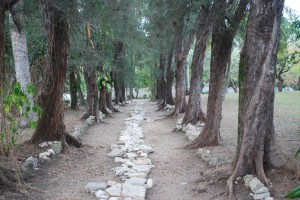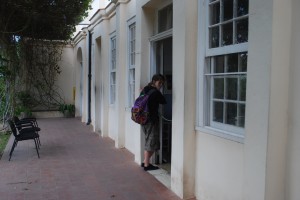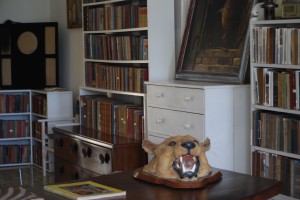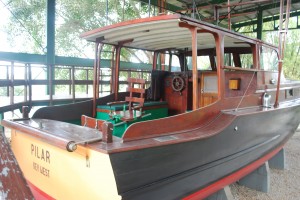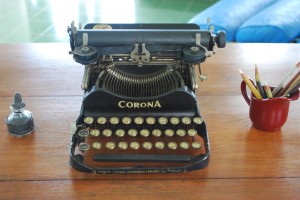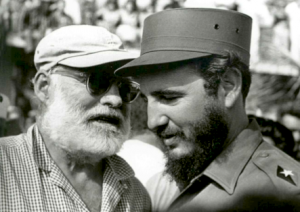Heritage Tourism and the Hemingway House
April 9, 2012 by admin
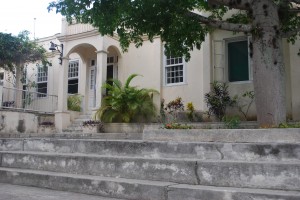
The front entrance to the Hemingway home, also called Finca Vigía, in San Francisco de Paula, just outside of Havana.
It is impossible not to notice Cuba’s reverence for famed U.S. American author, Ernest Hemingway. He is claimed almost as if he were Cuban himself by tour guides and friendly Cubans alike who proudly point out La Floridita and Hotel Ambos Mundos while wandering Old Havana. Many of Hemingway’s haunts were close to our hotel, just a short walk down Calle Obispo.
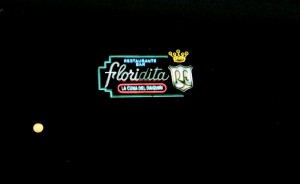
This sign for La Floridita, the bar Hemingway frequented for his daiquiris, probably looks familiar to many in our group.
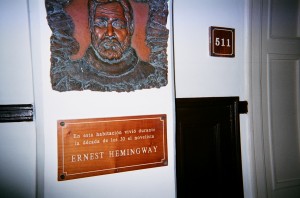
Hemingway’s time spent in this room in Hotel Ambos Mundos is memorialized with a plaque; the room has been unchanged since his stay.
His home, however, was not as nearby, and the cab ride to Finca Vigía was a long one. The house is tucked away in San Francisco de Paula, a suburb of Havana situated about nine miles from the city center, and the traffic in the provinces through which we passed seemed even busier than in the areas we visited as a whole tour group. Abound were rhythms of the street I didn’t often see: the gritty, the chaotic, the real.
An audio slideshow about Hemingway’s Cuba home was recently published in The Guardian. Journalist Conor Clarke echoes the above description of San Francisco de Paula: “When [Cubans] think about Hemingway, they like to remember that he didn’t move to one of the ritzy, touristy areas in Havana; He moved to this little tiny town that’s sort of populated by a lot of the same kinds of characters that occupy his novels” (Bell Tolls).
While the area did buzz with Hemingway pride, just like in Old Havana, the actual property is separated from its neighborhood by a wall. Lisa and Gordon mentioned that they had once (maybe twice) tried to visit the Finca Vigía on previous trips to Cuba, but the home was closed during the Special Period. They were unable to see much even by peeking through the front gate. The home is even further removed, accessible only down a long tree-lined avenue once one finally made it through the gate (where employees now ask for the 3 CUC entrance fee). Hidden by palm trees which buffer it from the sounds of a bustling neighborhood, the house didn’t immediately come into view.
Tourists are not allowed inside, but a veranda surrounds the one-story home. All windows and doors are wide open (only flimsy ribbons blocking them), and tourists circle the perimeter. While it would have been a treat to mosey around inside, it was still easy to see Hemingway’s treasures and read many of the titles of his thousands of books.

The shelves next to the toilet. Legend has it that one of his cats killed the lizard on the bottom right, but he preserved it because he thought “it put up a good fight.”
The property also includes a swimming pool, a guest house, and a tower from which he and his wife would use a telescope to look at the stars and the skyline of Havana in the distance. The former was under construction. I had the opportunity to talk with two of the workers about the project: they were restoring the walkway between a pair of dressing rooms behind the pool, using all original tiling and beams. Our conversation drifted to other subjects: low wages, the depressed economy and the family of one of the workers’ now in New Jersey. We all agreed that a parent’s separation from his children was unnatural, and I told him I hoped he would be able to visit them soon.
The last stop on my tour of Finca Vigía was to see Hemingway’s boat, Pilar, which he used to fish and to travel between his two homes, one in Cuba and one in Key West. I thought of how easy, how fluid it once was before the embargo to navigate between the two countries. Hemingway slipped across 90 mere miles from one to the other. Now, travel groups from the U.S., such as our own, wait months for government approval, then hours in airports for a half an hour flight. Travel for Cubans to the United States is almost never approved. Families are separated.
When I reflect on my visit to this home, I am reminded of our discussions of heritage tourism, of Cuba’s nine UNESCO World Heritage sites. Nine recognitions, for an island so small, is an impressive feat, but I’m inclined to believe that Cuba has many other places that are treasured by foreigners as well. And what an example, here in Cuba, the Finca Vigía: as much a gem of U.S. history and literature as Cuban.
Still, the embargo prohibit this type of exchange between our two nations. A recent U.S. attempt to restore the boat was squashed by the tightened policies of the Bush administration, but there exists a movement within the U.S. that is demanding government backing to restore this object of our history from termite damage and the improper “workmanlike [watercraft preservation] job” that the low budget afforded to Finca Vigía by the Cuban state could afford (Swanson).
Hemingway’s home has the potential to be a seed of friendship between the U.S. and Cuba. The
Hemingway Preservation Foundation along with the National Trust for Historic Preservation continues to lobby for the thorough restoration of Pilar and other parts of Finca Vigía. They accept tax-deductible contributions. Specific information can be found in Peter Swanson’s article in Yachting Magazine.
For more information about Hemingway in Cuba and the history of Finca Vigía, refer to the wonderful blog post that Laci published below. (The home definitely excited our inner English majors!)
Sources:
Bell Tolls for Hemingway’s Treasures as Cuban House Caught in Sanctions Trap. Perf. Conor Clarke. The Guardian, 17 July 2011. Web. 3 Apr. 2012. <http://www.guardian.co.uk/slideshow/page/0,,2128316,00.html>.
Salas, Osvaldo. Fidel y Hemingway. 1960. Photograph. Havana. Miradas Reveladoras. Institut Valencià D’art Modern, 2009. 33. Print.
Swanson, Peter. “Saving Pilar and Hemingway.” Yachting Magazine 3 Oct. 2007. Web. 9 Apr. 2012. <http://www.yachtingmagazine.com/cruising-chartering/yachting-life/saving-pilar-and-hemingway>.
Leave a Reply
You must be logged in to post a comment.
